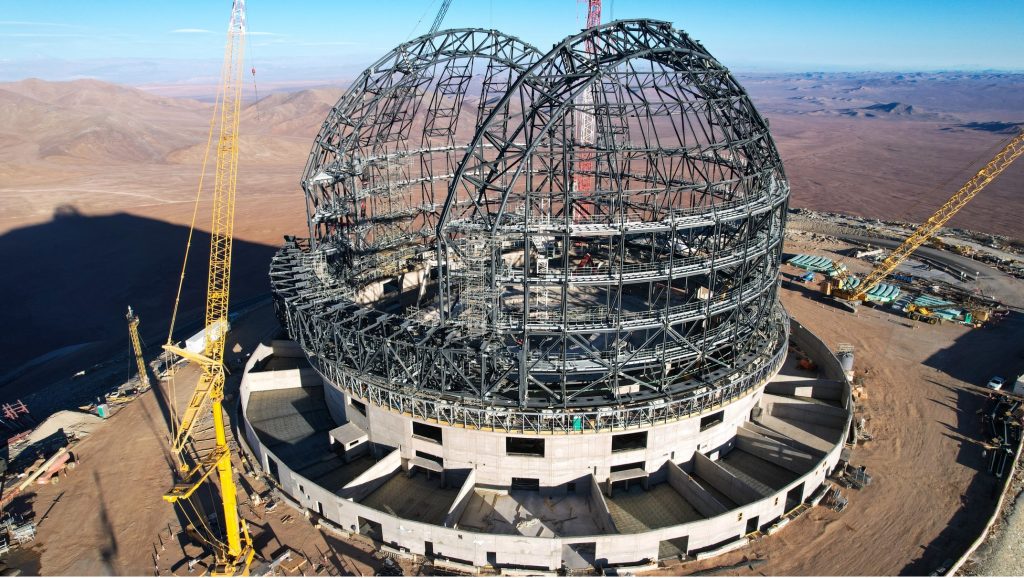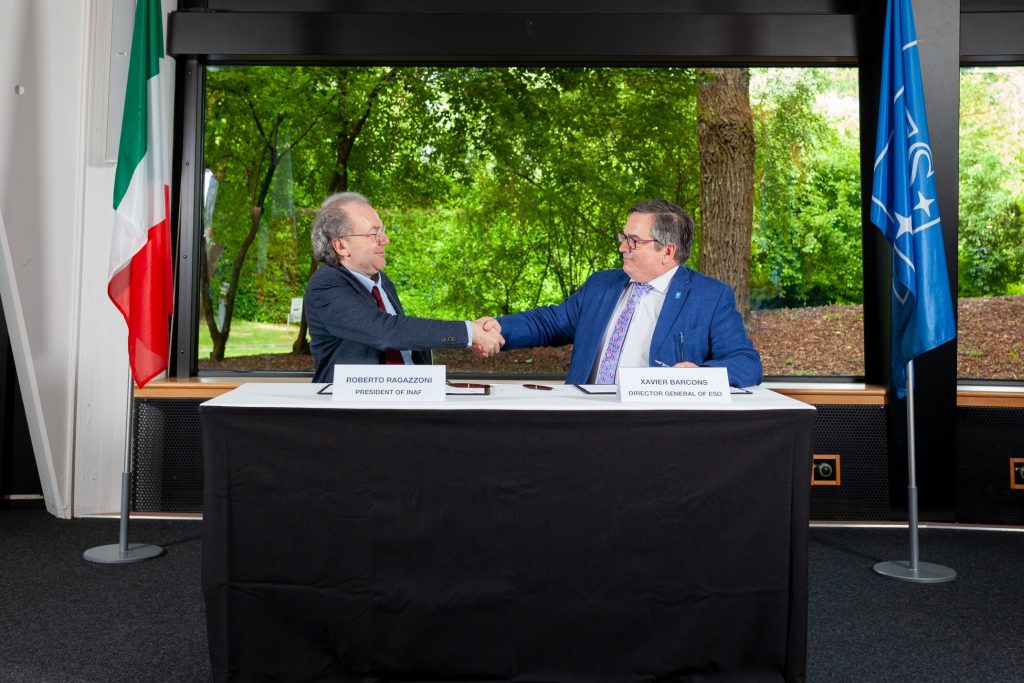A Canadian team joins ESO in milestone agreement for ANDES instrument on the ELT
On June 5th, the European Southern Observatory (ESO) signed an agreement with an international consortium of institutions for the design and construction of ANDES, the ArmazoNes high Dispersion Echelle Spectrograph. The ANDES instrument will be installed on ESO’s Extremely Large Telescope (ELT). It will be used to search for signs of life in exoplanets and look for the very first stars, as well as to test variations of the fundamental constants of physics and measure the acceleration of the Universe’s expansion. A Canadian team, represented by the Université de Montréal (UdeM) with members of the Centre for Research in Astrophysics of Quebec (CRAQ), is a key contributor to this groundbreaking project, with a lead role in the development of the near-infrared spectrograph and in providing skilled science personnel.
The agreement was signed by ESO’s Director General Xavier Barcons and by Roberto Ragazzoni, the President of Italy’s National Institute for Astrophysics (INAF), the institution leading the ANDES consortium. Also attending the signing ceremony were Vincenzo Fiorentini, Science Counselor at the Italian Embassy in Berlin and INAF’s Alessandro Marconi, ANDES Principal Investigator, in addition to other dignitaries from ESO, INAF and the ANDES consortium. The signing took place at the ESO Headquarters in Garching, Germany.
Formerly known as HIRES, ANDES is a powerful spectrograph, an instrument which splits light into its component wavelengths so astronomers can determine important properties about astronomical objects, such as their chemical compositions. The instrument will have a record-high wavelength precision in the visible and near-infrared regions of light and, when working in combination with the powerful mirror system of the ELT, it will pave the way for research spanning multiple areas of astronomy.
The Université de Montréal is proud to announce the commitment of Canadian scientists to the design and construction of ANDES, following the agreement signing by partners in the ANDES Consortium. The Canadian team is led by the Mont-Mégantic Observatory (OMM) and its Experimental Astrophysics Laboratory (LAE) under the leadership of Prof. René Doyon, co-PI of the Canadian ANDES Team and member of the CRAQ. The project also includes design work from the National Research Council’s Herzberg Astronomy and Astrophysics Research Centre all working in close collaboration with the Canadian ANDES science team co-led by Prof. Doyon and Prof. Kim Venn from the University of Victoria.

Photograph of the ELT’s dome, under construction in Chile. Photo Credit: ESO/G. Vecchia
The Canadian team is deeply involved in the development of the near infrared spectrograph, as well as the adaptive optics and control systems, data reduction pipeline, and in the provision of highly skilled science personnel. The ambitious goals of ANDES, such as detecting life signatures in exoplanet atmospheres and studying the Universe’s first stars, strongly align with the cutting-edge research conducted by Canadian scientists, particularly at UdeM’s Trottier Institute for Research on Exoplanets (iREx), Canada’s top exoplanet research centre. The ANDES Canadian team includes nine members from the UdeM community, each bringing substantial technical and project management expertise from their work on infrared components for projects like the SPIRou and NIRPS instruments, currently in operation in Hawai’i and Chile, respectively. This collaboration showcases Canada’s strong capabilities in the field of infrared astronomy and underscores the country’s leadership in astrophysical research and its commitment to advancing our understanding of our Universe.
“ANDES will significantly impact all fields of astrophysics with its unique ability to detect the spectral signatures of life in the atmospheres of potentially habitable exoplanets near the Sun,” says René Doyon, also a Professor at the Université de Montréal “It will also actively engage the Canadian astronomical community in utilising the ELT, which is set to become operational in a few years.”
“Canadian involvement in the ANDES project is made possible by the advanced infrared expertise developed at the OMM’s LAE,” says UdeM’s Dr. Frédérique Baron, Project Manager of the Canadian Instrument Team and member of the CRAQ. “This participation allows Canadian scientists to contribute to the design and construction of an instrument for the world’s largest telescope, granting Canadian astronomers valuable observing time to deepen our understanding of the Universe.”
ANDES will conduct detailed surveys of the atmospheres of Earth-like exoplanets, allowing astronomers to search extensively for signs of life. It will also be able to analyse chemical elements in faraway objects in the early Universe, making it likely to be the first instrument capable of detecting signatures of Population III stars, the earliest stars born in the Universe. In addition, astronomers will be able to use ANDES’ data to test if the fundamental constants of physics vary with time and space. Its comprehensive data will also be used to directly measure the acceleration of the Universe’s expansion, one of the most pressing mysteries about the cosmos.
ESO’s ELT is currently under construction in the Atacama Desert of Northern Chile. When operations start later this decade, the ELT will be the world’s biggest eye on the sky, marking a new age in ground-based astronomy.
More Information
The ANDES project is developed by an international consortium composed of research institutes in 13 countries. They are:
- Brazil: Board of Stellar Observational Astronomy, Universidade Federal do Rio Grande do Norte, Observatório Nacional.
- Canada: Observatoire du Mont-Mégantic and the Trottier Institute for Research on Exoplanets, Université de Montréal.
- Denmark: Instrument Centre for Danish Astrophysics on behalf of Niels Bohr Institute, Aarhus University, Danmarks Tekniske Universitet.
- France: Centre National de la Recherche Scientifique (CNRS) on behalf of Observatoire de la Côte d’Azur, Université Côte d’Azur (LAGRANGE), Laboratoire d’Astrophysique de Marseille, Aix-Marseille Université, Centre National d’Etudes Spatiales (LAM), Institut de Recherche en Astrophysique et Planetologie, Université Toulouse III-Paul Sabatier (IRAP), Institut de Planétologie et d’Astrophysique de Grenoble, Université Grenoble-Alpes (IPAG), Laboratoire Univers et Particules de Montpellier, Université de Montpellier (LUPM), Institut d’Astrophysique de Paris, Sorbonne Université (IAP), Laboratoire de Météorologie Dynamique, Ecole Normale Supérieure, Ecole Polytechnique, Sorbonne Université (LMD).
- Germany: Leibniz-Institut für Astrophysik Potsdam (AIP), Institut für Astrophysik und Geophysik, Georg-August-Universität Göttingen (IAG), Atmospheric Physics of Exoplanets Department, Max-Planck-Institut für Astronomie Heidelberg (MPIA), Zentrum für Astronomie, Universität Heidelberg (ZAH), Thüringer Landessternwarte Tautenburg (TLS), Hamburger Sternwarte, Universität Hamburg (UHH).
- Italy: INAF, Istituto Nazionale di Astrofisica (Lead Technical Institute).
- Poland: Nicolaus Copernicus University in Torun.
- Portugal: Instituto de Astrofísica e Ciências do Espaço (IA) at Centro de Investigaço em Astronomia/Astrofísica da Universidade do Porto (CAUP), Instituto de Astrofísica e Ciências do Espaço at Faculdade de Ciências da Universidade de Lisboa, Associação para a Investigação e Desenvolvimento de Ciências (FCiências.ID)
- Spain: Instituto de Astrofísica de Canarias (IAC); Consejo Superior de Investigaciones Científicas (CSIC, Spain) on behalf of Instituto de Astrofísica de Andalucía (IAA), Centro de Astrobiología de Madrid (CSIC-INTA).
- Sweden: Lund University, Stockholm University, Uppsala University.
- Switzerland: Département d’Astronomie, Université de Genève; Weltraumforschung und Planetologie, Physikalisches Institut, Universität Bern.
- United Kingdom: Science and Technology Facilities Council, United Kingdom Research and Innovation on behalf of Cavendish Laboratory & Institute of Astronomy, University of Cambridge; UK Astronomy Technology Centre; Institute of Photonics and Quantum Sciences, Heriot-Watt University.
- USA: Department of Astronomy, University of Michigan.
Links
- ESO Press Release: https://www.eso.org/public/announcements/ann24010/
- ESO ANDES Instrument Page: https://elt.eso.org/instrument/ANDES/
- ANDES Consortium Website: https://andes.inaf.it/
About the Centre for Research in Astrophysics of Quebec
The Centre for Research in Astrophysics of Quebec (CRAQ) brings together all the astrophysicists in Quebec. Nearly 150 people, including some fifty researchers and their students from Université de Montréal, McGill University, Université Laval, Bishop’s University, Cégep de Sherbrooke, Collège de Bois-de-Boulogne and a number of other collaborating institutions are part of the cluster. The CRAQ is under the direction of David Lafrenière of the Université de Montréal. The CRAQ is one of the strategic clusters funded by the Fonds de recherche du Québec – Nature and Technologies (FRQNT).
Science Contacts
René Doyon
Co-PI of the Canadian Core Science Team for ANDES
Département de physique – Université de Montréal
Complexe des Sciences
PO Box 6128 Centre-Ville STN
Montreal QC H3C 3J7
Canada
doyon@astro.umontreal.ca
Frédérique Baron
Project Manager for the Canadian Instrument Team for ANDES
frederique.baron@umontreal.ca
Media Contacts
Heidi White
Outreach Officer – ANDES Canadian Instrument Team
heidi.white@umontreal.ca
Frédérique Baron
Project Manager for the Canadian Instrument Team for ANDES
frederique.baron@umontreal.ca

